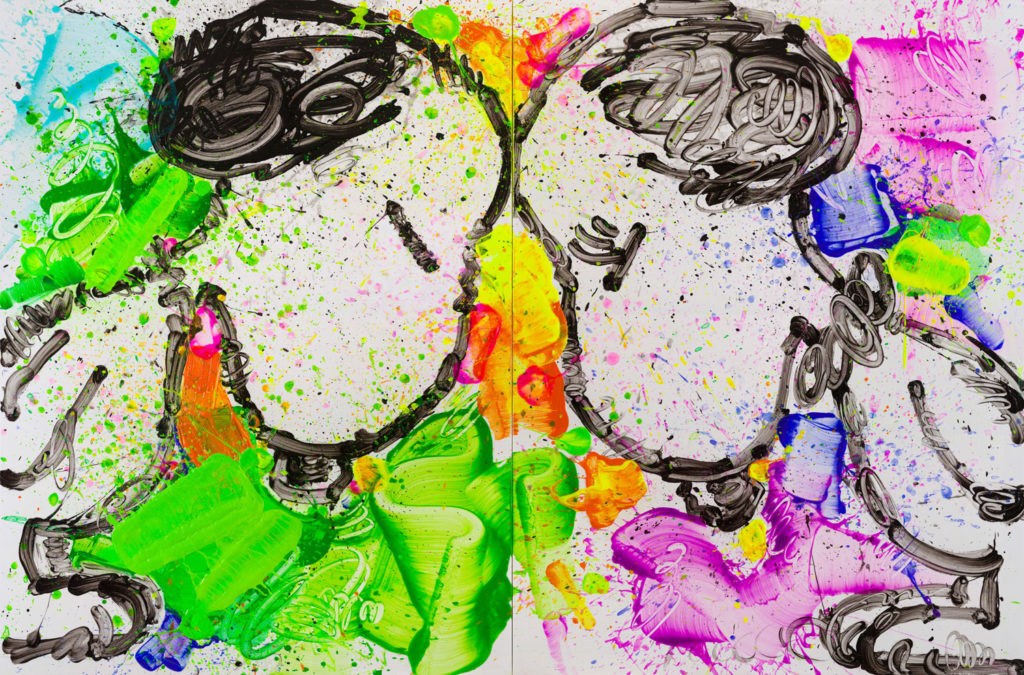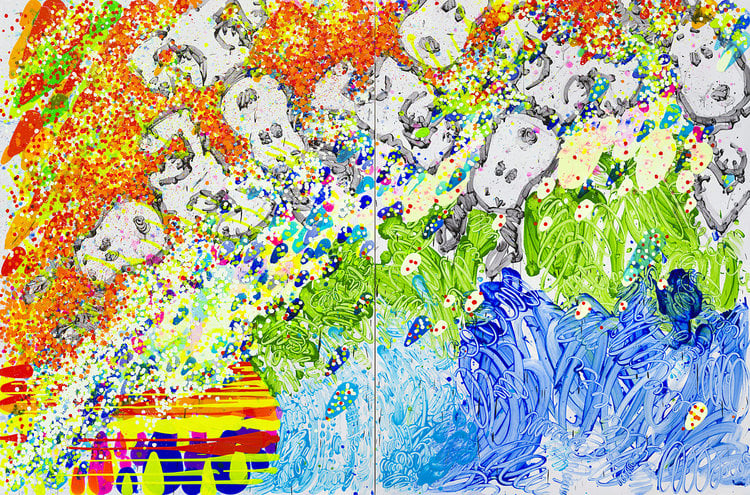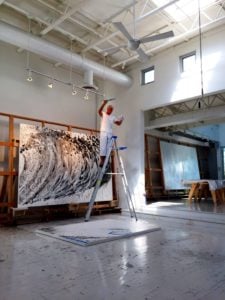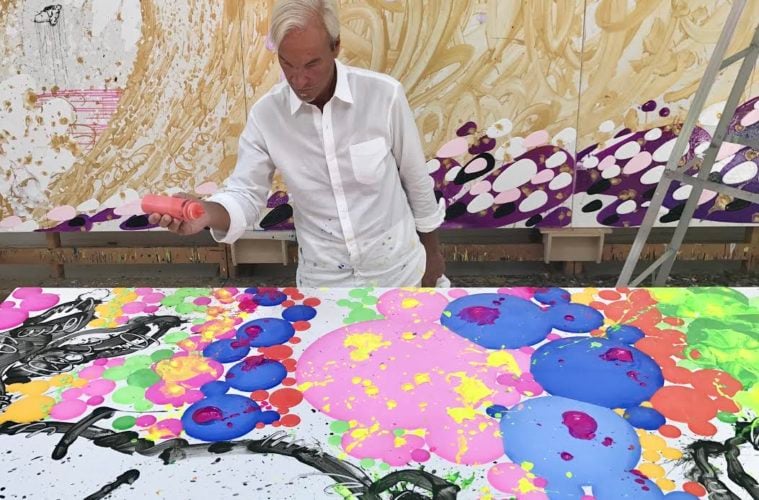Tom Everhart’s signature style is a lively and profound hybrid of pop and expressionist visual elements, infused with an art historical perspective and a cheeky sense of humor. As a contemporary of Warhol, Haring, Scharf and Basquiat during formative New York City years, Everhart’s work in that zeitgeist was nevertheless more than just bright and cartoonish. His closeness since 1980 with the late, legendary Peanuts creator Charles M. Schulz not only garnered Everhart firsthand training to create and perpetual permission to use those characters in his own work, it also sparked a lively conversation about how flatness, color, texture and a uniform gestalt defines modern visual art. In fact, Everhart’s first major exhibition was at the Louvre in Paris in conjunction with a Schulz survey.
Since then, Everhart’s wry commentary on issues from politics to the environment, culture wars, and the art world have been suffused into often monumentally-scaled paintings based on the iconic comic strip characters, combining confident lines and vibrant color to create surreal, expressive, hilarious, and absolutely joyful experiences. In advance of a major local (finally!) show of new work in November at Mouche Gallery, Everhart will be speaking at CMATO in Thousand Oaks on Saturday, January 11, in conjunction with their current group show Empathy: Beneath the Surface.

Tom Everhart, Brothers and Sisters Please (2018)
L.A. WEEKLY: When did you first know you were an artist?
TOM EVERHART: Of course it would be more romantic of a story to say that as a young child my crayons pushed my visual activity enough to open my creative thought to the unfamiliar strategies and visual constructions of painting. But, I was not yet making distinctions between the coloring book and the art of museums. I don’t think it was until my fresh post-art academia, along with my new lower Manhattan friends full of mischievous reckless behavior, when we confronted the same old clichés of art and the conventions that govern how we recognize art as art, that I was finally receptive to new and other ways of seeing, and felt like an artist.
What is your short answer to people who ask what your work is about?
In short, the work of the last 32 years is focused on the irresistible possibilities of what I can’t ignore, expressed through the collision of usually segregated art forms of painting and cartooning. The visual object matter, pulled from one singular and very familiar cartoon, is used as a subversive method of camouflage for the actual subject matter of my own sociopolitical feelings and personalized sensibilities, so as not to lose the onlooker through an immediate visual content.

Tom Everhart, The Rogue Wave and the Broken Rib (2016-17)
What would you be doing if you weren’t an artist?
Because I have absolutely no idea what I would do, I have for most of my adult life made good friends with most of the best chefs and restaurants (and the locations of their food dumpsters) just in case.
Did you go to art school? Why/Why not?
I have been very fortunate to grow up in cities with great art museums. My constant visits left me with many questions about the way we see and visually articulate, making art academia inevitable for seven years, including undergraduate, graduate, and post graduate work.
Why do you live and work in L.A., and not elsewhere?
I first came to Los Angeles in 1982 with a group of New York art friends (whose work you would mostly now know). We crashed in a gallery/home on Market Street in Venice, just off of Speedway. It was just as tough and nasty as the East Village/the Bowery, but had a beach. Let’s say that we were not welcomed with flowers and hugs from the L.A. artists in Venice, but with a large bouquet of “we don’t take kindly to your kind.” It was almost as if we had paddled out into another surfer’s territory. Nonetheless, we would return to Market Street for the next couple of years. Soon after, I kept part time work spaces between Venice, New York, Baltimore and London. A few years after the New York art world finally decentralized, I moved full-time to Venice in 1997. In 2000, I added a studio in French Polynesia.
Essentially and most importantly, it was that Los Angeles was the only city that had a sense of humor about itself.

Tom Everhart in his Venice Studio with Surfing with Franz and Willem (2015)
When was your first show?
There were so many experimental spaces in New York in the 1980s, it’s hard to say where it was for me. Personally, my first show was the Louvre Museum exhibition, in 1990, two years after my new cartoonish imagery had begun to offend the notion of taste as it was generally known and accepted in the art world.
When is/was your current/most recent/next show?
My most recent show was Sleeping Beauties in Chelsea at the Chase Contemporary Gallery. Coconut Radio, the next body of new work, will be exhibited in 2020 at the Mouche Gallery in Beverly Hills, and right now I have some work in a group exhibition at CMATO in Thousand Oaks.
What artist living or dead would you most like to show with?
Because my imagery is formulated on the influence of how things feel while undermining the certainty of appearances, I would probably pick a show with J.M.W. Turner. His methods of tying himself to the front of trains and ocean liners just to produce paintings about wind and steam, not to mention his offensive behavior with London’s Royal Academy, would make him the perfect unlikely pick.

Tom Everhart, Rolling with the Homies (2000-12)
Do you listen to music while you work? If so what?
I listen to ’90s hip-hop and new hip-hop influenced by ’90s hip-hop, very loudly.
Website and social media handles, please!
facebook.com/TomEverhart.Studio
instagram.com/tomeverhartstudios
Advertising disclosure: We may receive compensation for some of the links in our stories. Thank you for supporting LA Weekly and our advertisers.

